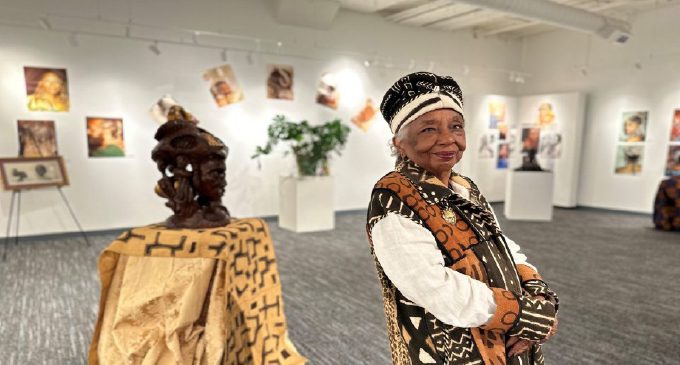Exhibit pays tribute to ‘Queen Mother of Braids’
Rosa “Malikia” Johnson --Photo courtesy of the Arts Council of Winston-Salem

In the 1960s with one simple phrase, “Black is Beautiful,” young Black men and Black women across the country started a movement to inspire others to embrace Black culture and identity. The movement affirmed Black music, writing, fashion, and all forms of art. And for Oakland native Rosa “Malikia” Johnson, that art form was hair sculpting.
Johnson, who is known as the Queen Mother of Braids, started braiding hair and teaching the technique at the height of the Black is Beautiful movement and after perfecting her craft, she began braiding the hair of celebrities like Abbie Lincoln, Cicely Tyson, Nina Simone, members of Earth, Wind and Fire, and Stevie Wonder.
Johnson said when she first started braiding in the early 1960s, the style was just used to make it easier to style the afro. But by the late 1960s more women started wearing their hair in braids and that’s when more designs and styles were introduced. Johnson said she didn’t start charging until it was suggested by legendary singer and composer Abbey Lincoln. Lincoln was close friends with Johnson’s aunt, Maya Angelou.
“Abbey suggested it … she said, you know you can make a living doing this. And I hadn’t thought about that really; however, I did have four children to support, so I did start charging,” Johnson said.
As her skills improved, Johnson said she started to gain inspiration from designs she saw in African art. Johnson said she saw designs in masks and paintings that she used in her own work.
“Because I was fascinated by African art I saw designs in all those masks,” Johnson continued. “Designs in the cloth. I was absolutely fascinated with African art that was spurred by my Aunt Maya’s teachings.”
Johnson said she made the connection with Stevie Wonder while working at a shop in Los Angeles. Johnson said she was already working with Earth, Wind & Fire when she put the word out that she would braid Stevie’s hair for free. A few weeks later Johnson received a call from Stevie’s brother, a few weeks after that Stevie and his entourage stopped by the shop, and the rest is history. “His appointment was at seven that evening … he got there at about one in the morning and we braided all night long,” Johnson laughed.
Johnson traveled with Stevie Wonder over a decade, making sure his hair was just right for every photoshoot, performances, and even Grammy appearances. She said while working with famous singers, she developed what she calls “speed braiding.”
Johnson also had the opportunity to travel and see the world with singer and civil rights activist Nina Simone. When discussing her time traveling with Nina Simone, one of the leading voices of the civil rights movement, Johnson said that’s when she started to feel the confidence to be herself.
“I was in Australia with her and I was in Paris with her, I was in Nijmegen with her, and it was fascinating,” Johnson continued. “It was a wonderful experience … she gave me what she called ‘my voice’ … the will to be my strong self.”
About 25 years ago, after traveling the world with the stars, Johnson moved to Winston-Salem to be with her aunt. Johnson’s work is the center of the exhibit “Straw into Gold: A Photographic Journey featuring Rosa ‘Malikia’ Johnson” currently on display at the Milton Rhodes Center for the Arts, 251 N. Spruce St.
The exhibit, which was curated by Johnson’s daughter, Matema Hadi, features more than one hundred photographs and other items highlighting Johnson’s journey.
The exhibit will be on display until March 11. For more information on the exhibit visit https://www.intothearts.org/strawintogold.
Clips of the interview with Rosa “Malikia” Johnson are available on The Chronicle’s Facebook, Instagram, and SnapChat platforms.










